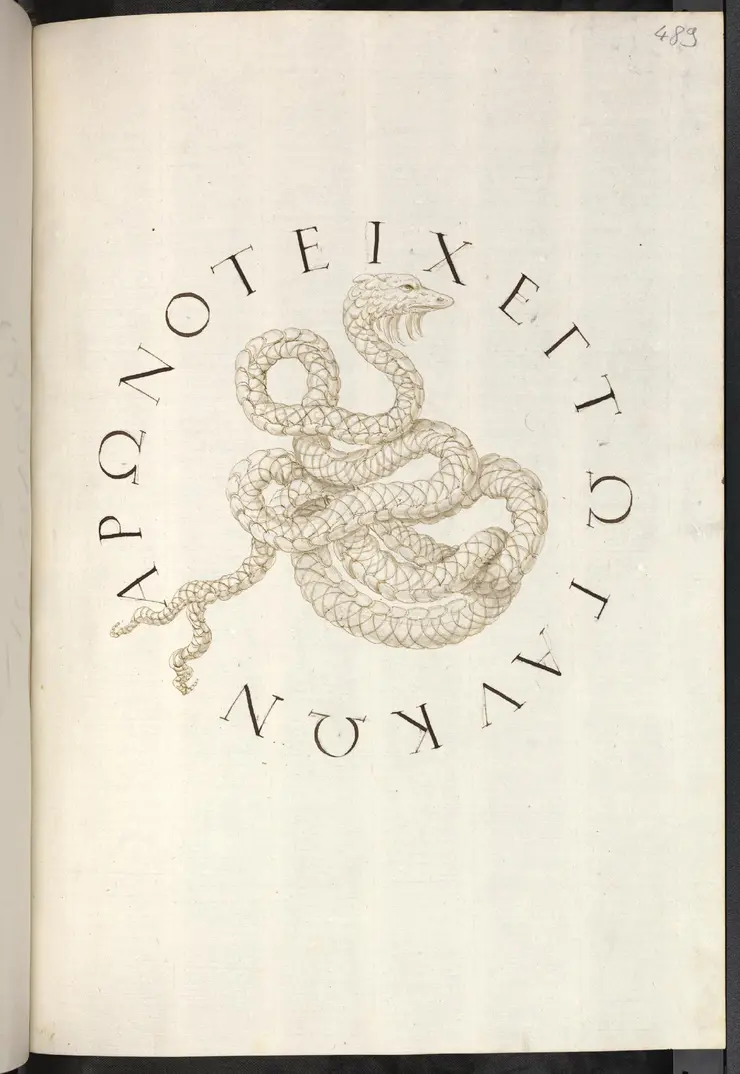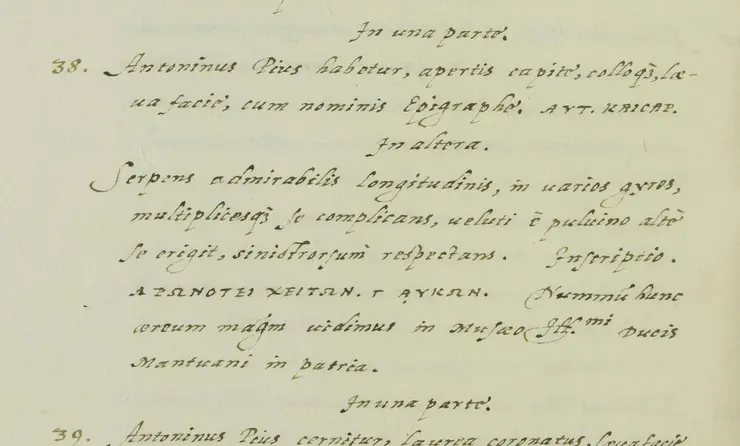Stradas A. A. A. NvmismatΩn Antiqvorvm ΔΙΑΣΚΕΥΗ (Diaskeué)

During Strada’s travels hunting for ancient coins to acquire or document both for himself and for Hans Jakob Fugger in connection with his commission for the Magnum ac Novum Opus, Strada built up a huge amount of visual documentation. He used this not only used to prepare the designs for the finished drawings in the Magnum Opus, but also to prepare written descriptions of each singular coin, in an attempt to build up what is perhaps the first textual corpus of ancient numismatics. This scholarly endeavour is partly due to his connection with Fugger, who had been trained from his early youth in humanist scholarship, and had developed an encyclopaedic interest in the sciences and arts, reflected in his own collection, and later in his involvement in the huge complex of collections realized in Munich, partly under his direct supervision.
Fugger’s most obvious example was the Inscriptiones sacrosanctae vetustatis, the earliest corpus of ancient inscriptions assembled by Peter Apianus and Bartolomeus Amantius, including objects from Hans Jakob’s father, Raymund Fugger, and published in 1534 at Ingolstadt at the latter’s expense.
Strada’s effort resulted in a huge work known in only two virtually identical manuscripts, preserved in the Vienna University Library, and the Czech National Library in Prague:
A. A. A. NvmismatΩn Antiqvor ΔΙΑΣΚΕΥΗ : hoc est, Chaldaeorum, Arabum, Libycorum, Graecorum, Hetruscorum, ac Macedoniae, Asiae, Syriae, Aegypti, Syculorum, Latinorum, Seu Romanorum Regum, a primordio Vrbis, Deum, Coss. tempore Reipub: & crescente adhuc, tam sub Caess. Latinis, in occidente, quam Graecis Impp. in oriente, declinante Imperio P. R. denique [?] Hexarchorum, Barbarorum Principum, Ducumue: Metallicarvm Eiconvm explicatio // Ex Mvsaeo Iacobi Stradae Mantuani / Antiquarij, Civis Romani:
That is:
Instrument of Ancient G[olden], S[ilver] and B[ronze] Coins: that is, Explanation of the metal images of the Chaldean, Arabic, Libyan, Greek, Etruscan, as well as Macedonian, Asian, Syrian, Egyptian, Sicilian, Latin, or Roman Kings, from the foundation of the City, Gods, Consuls from the time of the Republic and hitherto, both under the Latin Caesars, in the West, and under the Greek Emperors, in the East; and then when the Empire of the Roman people was declining, [those of the] Hexarchs and the Princes and Dukes of the Barbarians. From the Musaeum of Jacopo Strada, Antiquary from Mantua, Roman Citizen.
Unlike the Magnum opus, dedicated to Roman Imperial coinage only, the ΔΙΑΣΚΕΥΗ is a finished work, covering all of the ancient world: it is not the textual complement to the images of the Magnum Opus. Though such a complement was intended, this was never realized because of Fugger’s financial troubles, and Duke Albrechts V. reluctance to spend any more money on the project. Later, more restricted versions of Strada’s Series Imperatorum of imperial coins, based on the material hee had collected, such as one separate volume also in Gotha, do include similar description of the coins illustrated.
Both complete copies of the ΔΙΑΣΚΕΥΗ [“instrument” or “manual”] consist of eight huge folio size volumes of coin descriptions, complemented by three volumes of alphabetical, chronological, and systematic indices. The scholarly character of Strada’s endeavour is borne out by its attempt at completeness, the addition of the indices, and most of all, the development of a uniform, methodical, structured format for the descriptions.

Strada’s description: in Διασκευη 5, Antonini Pij Graeca, fol. 63v, p. 1247, no 38:
In una parte: Antoninus Pius habetur, apertis capite, colloque, laeva facie, cum nominis Epigraphe. ΑΥΤ. ΚΑΙCΑΡ.
On one side: Antoninus Pius is seen, with uncovered head and neck, with his face turned to his left, with his name in the inscription ΑΥΤ. ΚΑΙCΑΡ.
In altera: Serpens admirabilis longitudinis, in varios gyros, multiplicesque se complicans, veluti e pulvino alte se erigit, sinistrorsum respectans. Inscriptio. ΑΡΩΝΟΤΕΙ ΧΕΙΤΩΝ. Γ ΑΥΚΩΝ. Nummum hunc aereum magnum vidimus in Musaeo Ill.mi Ducis Mantuani in patria.
On the other side: A serpent of admirable length, winding and twisting itself in several circles, raises itself up high as if from a bed of earth, looking to its left. The inscriptions [reads] ΑΡΩΝΟΤΕΙ ΧΕΙΤΩΝ. Γ ΑΥΚΩΝ. We saw this big golden coin in the Musaeum of the most illustrious Duke of Mantua in [our] hometown.
Obverse and reverse are separately described, paying attention to particular distinguishing features, such as the direction and the hairstyle of the portrait head, and always transcribing the legends whenever present and readable. At the end of the description Strada always mentions the place where he has seen the best exemplar of the coin type, and the name of the collector.
The later information is interesting because it both allows conclusions as to Strada’s itinerary, and on a number of sixteenth-century coin collections. Many coins were in fact in the collections of Fugger and of Jacopo Strada himself.
The tiles below present the links to each individual volume in their correct order.
A detailed survey of the contents of the volumes can be found here.
The Vienna version of the ΔΙΑΣΚΕΥΗ, Universitätsbibliothek Vienna, Signatur III-161898, 1–11, has been digitized and can be consulted.





